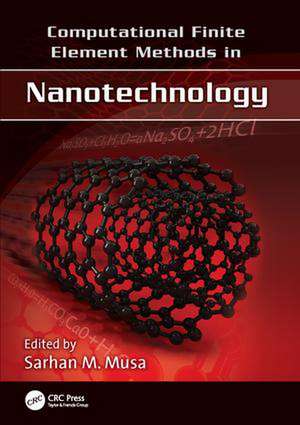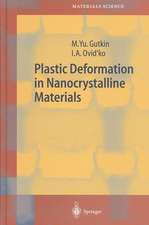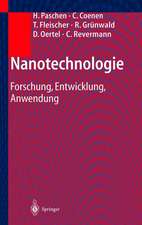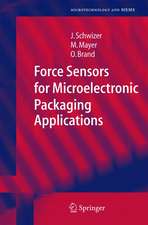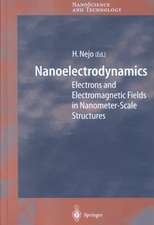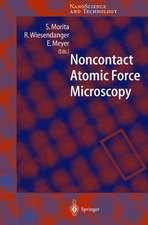Computational Finite Element Methods in Nanotechnology
Editat de Sarhan M. Musaen Limba Engleză Paperback – 29 mar 2017
The book explores a variety of topics, including:
- A novel FE-based thermo-electrical-mechanical-coupled model to study mechanical stress, temperature, and electric fields in nano- and microelectronics
- The integration of distributed element, lumped element, and system-level methods for the design, modeling, and simulation of nano- and micro-electromechanical systems (N/MEMS)
- Challenges in the simulation of nanorobotic systems and macro-dimensions
- The simulation of structures and processes such as dislocations, growth of epitaxial films, and precipitation
- Modeling of self-positioning nanostructures, nanocomposites, and carbon nanotubes and their composites
- Progress in using FEM to analyze the electric field formed in needleless electrospinning
- How molecular dynamic (MD) simulations can be integrated into the FEM
- Applications of finite element analysis in nanomaterials and systems used in medicine, dentistry, biotechnology, and other areas
| Toate formatele și edițiile | Preț | Express |
|---|---|---|
| Paperback (1) | 585.27 lei 6-8 săpt. | |
| CRC Press – 29 mar 2017 | 585.27 lei 6-8 săpt. | |
| Hardback (1) | 1466.59 lei 6-8 săpt. | |
| CRC Press – 19 oct 2012 | 1466.59 lei 6-8 săpt. |
Preț: 585.27 lei
Preț vechi: 688.56 lei
-15% Nou
Puncte Express: 878
Preț estimativ în valută:
111.100€ • 119.76$ • 93.38£
111.100€ • 119.76$ • 93.38£
Carte tipărită la comandă
Livrare economică 17 aprilie-01 mai
Preluare comenzi: 021 569.72.76
Specificații
ISBN-13: 9781138076884
ISBN-10: 1138076880
Pagini: 640
Ilustrații: 498; 27 Tables, black and white; 411 Illustrations, black and white
Dimensiuni: 178 x 254 x 33 mm
Greutate: 0.45 kg
Ediția:1
Editura: CRC Press
Colecția CRC Press
ISBN-10: 1138076880
Pagini: 640
Ilustrații: 498; 27 Tables, black and white; 411 Illustrations, black and white
Dimensiuni: 178 x 254 x 33 mm
Greutate: 0.45 kg
Ediția:1
Editura: CRC Press
Colecția CRC Press
Cuprins
Overview of Computational Methods in Nanotechnology. Finite Element Method for Nanotechnology Applications in Nano-/Microelectronics. Modeling, Design, and Simulation of N/MEMS by Integrating Finite Element, Lumped Element, and System Level Analyses. Nanorobotic Applications of Finite Element Method. Simulations of Dislocations and Coherent Nanostructures. Continuum and Atomic-Scale Finite Element Modeling of Multilayer Self-Positioning Nanostructures. Application of Finite Element Method for the Design of Nanocomposites. Finite Element Modeling of Carbon Nanotubes and Their Composites. Finite Element–Aided Electric Field Analysis of Needleless Electrospinning. Molecular Dynamic Finite Element Method (MDFEM). Application of Biomaterials and Finite Element Analysis (FEA) in Nanomedicine and Nanodentistry. Application of Finite Element Analysis for Nanobiomedical Study. Finite Element Method for Micro and Nano-Systems for Biotechnology. Design of the Nanoinjection Detectors Using Finite Element Modeling. Finite Element Method (FEM) for Nanotechnology Application in Engineering: Integrated Use of Macro-, Micro-, and Nano-Systems. Modeling at the Nano Level: Application to Physical Processes. Appendix A: Material and Physical Constants. Appendix B: Symbols and Formulas. Index.
Notă biografică
Sarhan M. Musa, Ph.D., is currently an associate professor in the Department of Engineering Technology at Prairie View A&M University, Texas. He has been director of Prairie View Networking Academy, Texas, since 2004. Dr. Musa has published more than 100 papers in peer-reviewed journals and conferences and is the editor of Computational Nanotechnology Modeling and Applications with MATLAB®. He currently serves on the editorial board of the Journal of Modern Applied Science. Dr. Musa is a senior member of the Institute of Electrical and Electronics Engineers (IEEE) and is also a 2010 Boeing Welliver Fellow.
Descriere
This book demonstrates the capabilities of finite element methods (FEMs) in nanotechnology for a range of fields. Bringing together contributions from researchers around the world, it covers key concepts as well as cutting-edge research and applications to inspire new developments and future interdisciplinary research. In particular, it emphasizes the importance of FEMs for computational tools in the development of efficient nanoscale systems. A one-stop reference for professionals, researchers, and students, this is also an accessible introduction to computational FEMs in nanotechnology for those new to the field.
